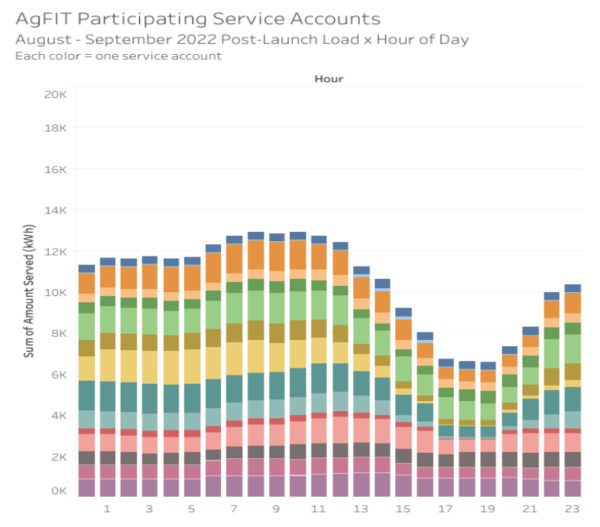The California Community Choice Association (CalCCA) has called for state regulators to expand an opt-in dynamic pricing pilot to farmers statewide.
CalCCA made the proposal in a California dynamic pricing rulemaking proceeding focused on increasing demand flexibility for electricity, in order to reduce the curtailment of renewable generation, enhance grid reliability, and reduce system costs.
A 5 MW opt-in pilot project involving automated agricultural pumping by customers of one community choice aggregator has cost-effectively shifted “significant” agricultural load in both the ramp and peak hours, CalCCA said. On that basis, CalCCA proposed expanding the pilot to serve farmers across the territories of the state’s investor-owned utilities, to reach “up to 500 MW” in load flexibility capacity.
CalCCA represents the interests of 24 community choice electricity providers in California. According to California utility PG&E, over 60% of PG&E customers take their generation service from one of 12 community choice aggregators in the utility’s service area.
CalCCA’s proposed value of 500 MW of eligible capacity is approximately equal, the group said, to the statewide load shift potential identified in a Lawrence Berkeley National Laboratory study for agricultural pumping and processing, after conversion from gigawatt-hours to MW of peak load. CalCCA said an expanded dynamic pricing program should be open to all types of agricultural customer load, not just irrigation pumping.
CalCCA submitted its proposal in response to a question, posed by the California Public Utilities Commission (CPUC) in the dynamic pricing rulemaking, about whether to expand dynamic pricing pilots.
 CalCCA presented pilot project data showing that electricity consumption by project participants last August and September fell sharply in the 5 p.m. to 8 p.m. period, when air conditioning needs were high, as illustrated in the nearby bar chart.
CalCCA presented pilot project data showing that electricity consumption by project participants last August and September fell sharply in the 5 p.m. to 8 p.m. period, when air conditioning needs were high, as illustrated in the nearby bar chart.
Participants in the pilot project are all customers of Valley Clean Energy Alliance (VCE), a community choice aggregator. VCE’s interest in the pilot project stemmed from the Berkeley Lab study showing the high load shift potential for irrigation pumping, CalCCA said in its proposal.
California has approved or is considering eight real-time pricing pilot programs, according to the Public Advocates Office of the CPUC.
Nationwide, $33 billion in annual savings would result from allowing customers to opt in to real-time pricing that balances renewables, thus shifting some consumption to lower-cost periods, according to a study by the Pacific Northwest National Laboratory. Customer bills would be reduced by 10% to 17%, the study said.
A supplier of automated irrigation pumps, Polaris Energy Services, also commented to the CPUC in support of expanding the VCE pilot program, as did TeMix, which developed the real-time pricing platform for the VCE pilot.
This content is protected by copyright and may not be reused. If you want to cooperate with us and would like to reuse some of our content, please contact: editors@pv-magazine.com.








So, this is the plan. Take all those rich folks solar for a 75% discount, then let the farmers get a 20% discount on all that excess electricity. The utility makes a 65% profit on the deal because they did not pay for any of the excess electricity they got to keep. Poor farmers get a crumb, and the utility gets a side of beef. Big Agra business in California is what California is all about.